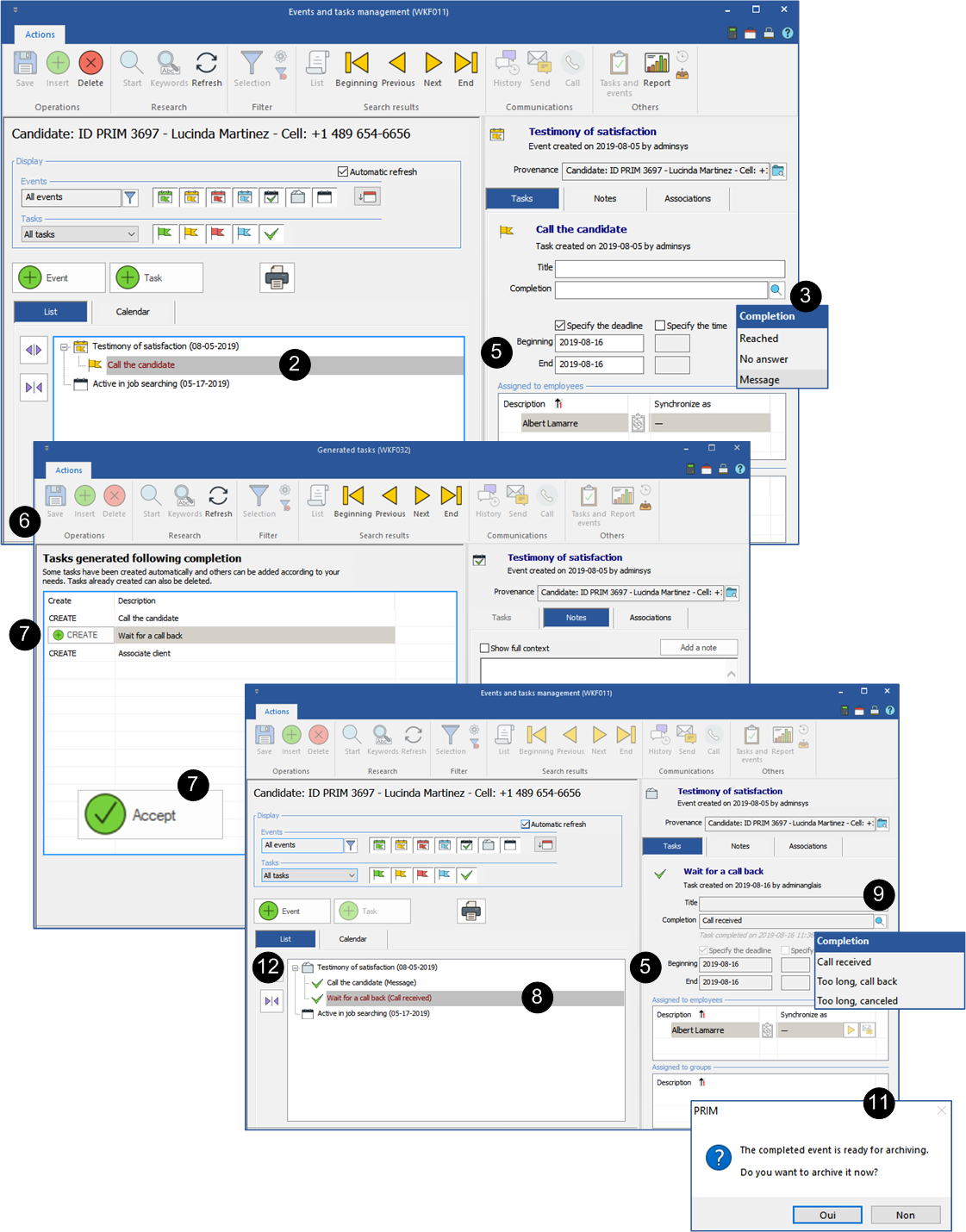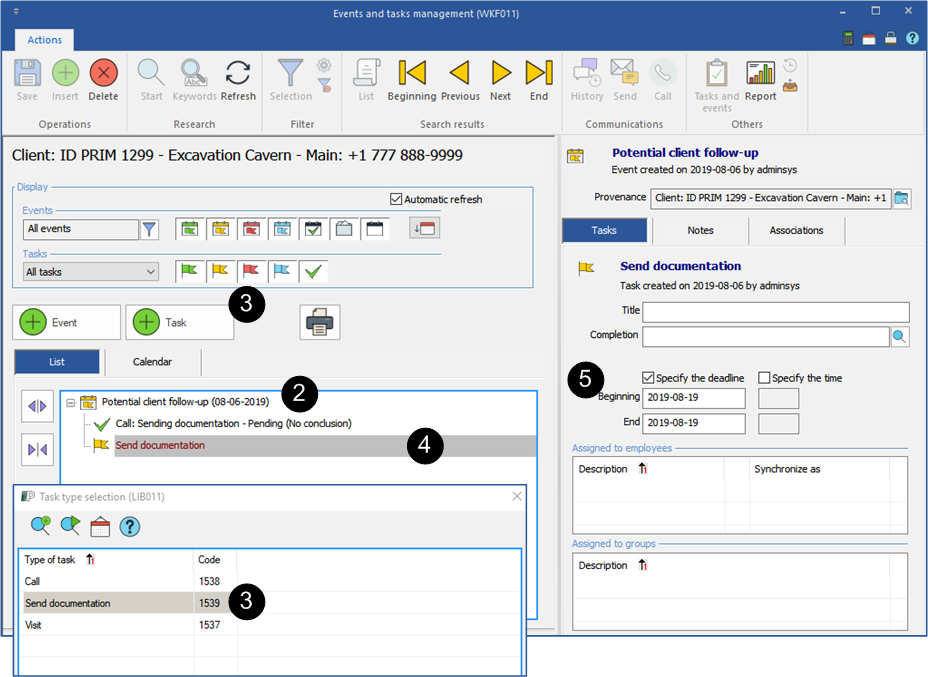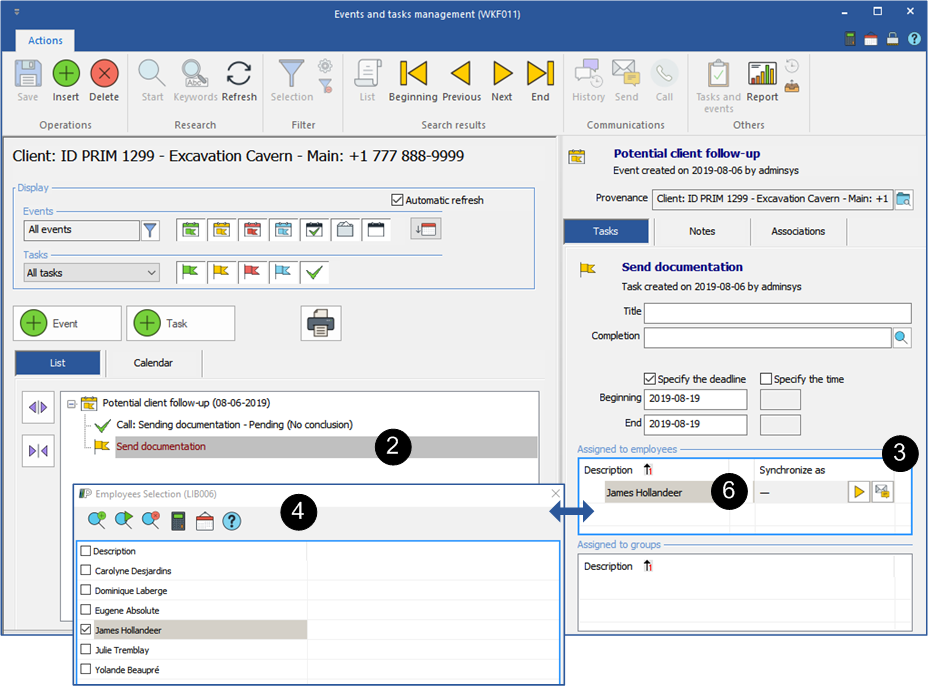Events and tasks management
![]() The types of events and tasks associated with these events are configured according to your company's specific needs. The completion choices or events illustrated in the examples below may be different.
The types of events and tasks associated with these events are configured according to your company's specific needs. The completion choices or events illustrated in the examples below may be different.
 Complete tasks and archive the event
Complete tasks and archive the event
The completion of tasks is possible from the "Event and task management" window or from the "To do tasks" window, the completion procedure is identical in both windows.
The example below illustrates the completion of tasks related to the "Testimony of Satisfaction" event for a candidate.
1.Open the candidate's file and the "Event and task management" window. 2.Select the task "Call the candidate" under the event "Testimony of satisfaction". 3.Click on the icon 4.Press the icon 5.Depending on your configuration, the due date of the task could be automatically registered and it is possible to modify it. Otherwise, check the "Specify the deadline" box to activate the text fields and enter a date. 6.The selected completion option may suggest that you add a new task. In this case, the "Generated Tasks" window will appear to allow the creation of a new task related to the event. 7.In the "Generated Tasks" window, select the "Wait for a call back" task. Click on the button 8.The new task has been added to the list. Select this task. 9.Click on the icon 10.Press the icon 11.If the selected completion option is the last task to complete the event, a message will be displayed asking you if you want to archive the event now. 12.If you answer 13.If you answer
|
 Add a note related to an event or task
Add a note related to an event or task
For clarification, a note can be added to a newly created or existing task or event.
Add a note
1.Open the "To do tasks" window. 2.If needed, apply a filter to events and tasks. 3.Select a task or event and move to the "Notes" tab. 4.Click on the button 5.Details are visible in the note display area.
Modify or delete a note
6.Select the note for which you want to make a change. 7.Click on the "Modify" link to open the note editing window. 8.You will be able to delete or edit the text of the note.
|
 Add an event
Add an event
The example below illustrates the addition of the "Complaint" event to a candidate's file.
1.Open the candidate's file and the "Event and task management" window. 2.Click on the button 3.The event and its associated tasks are added to the file. 4.You can add a personalized title to the event, to specify its nature or subject.
|
 Associate an event
Associate an event
Associating an event between two folders will make it possible to find this event in the two folders concerned in order to facilitate its follow-up.
The example below illustrates an association between a candidate and a client following a complaint made by the client who was not satisfied with a candidate's work.
1.Open the candidate's file and the "Event and task management" window. 2.Add the "Complaint" event if it is not already added to the file. 3.Select the task "Link complaint to client" and click on the icon 4.In the message that appears, press 5.Click on the icon 6.Press the icon 7.Move to the "Tasks" tab and complete the task. The event is added to the client's file and contains the information from the file to which the event is associated. 8.You can complete the other tasks and archive the event, if necessary.
|
 Add a task
Add a task
The example below illustrates the addition of the task "Sending documentation" under the event "Potential client follow-up" in a new client's file.
1.Open the client's file and the "Event and task management" window. 2.Select the event "Potential client follow-up". 3.Click on the button 4.The task is added to the folder. 5.If necessary, specify the due date of the task.
|
 Assign a task
Assign a task
PRIM allows you to assign a task to a user or a security group.
The example below illustrates the assignment of the "Send documentation" task to a user from a client's file. Note that the procedure is the same for assigning a task to a security group.
1.Open the client's file and the "Event and task management" window. 2.Select the event "Potential client follow-up" and the task "Send documentation". 3.Click on a blank line in the "Assigned to employees" section to open the selection window. 4.Select an employee from the list provided. 5.Press the icon 6.The task is assigned to the selected user.
|






